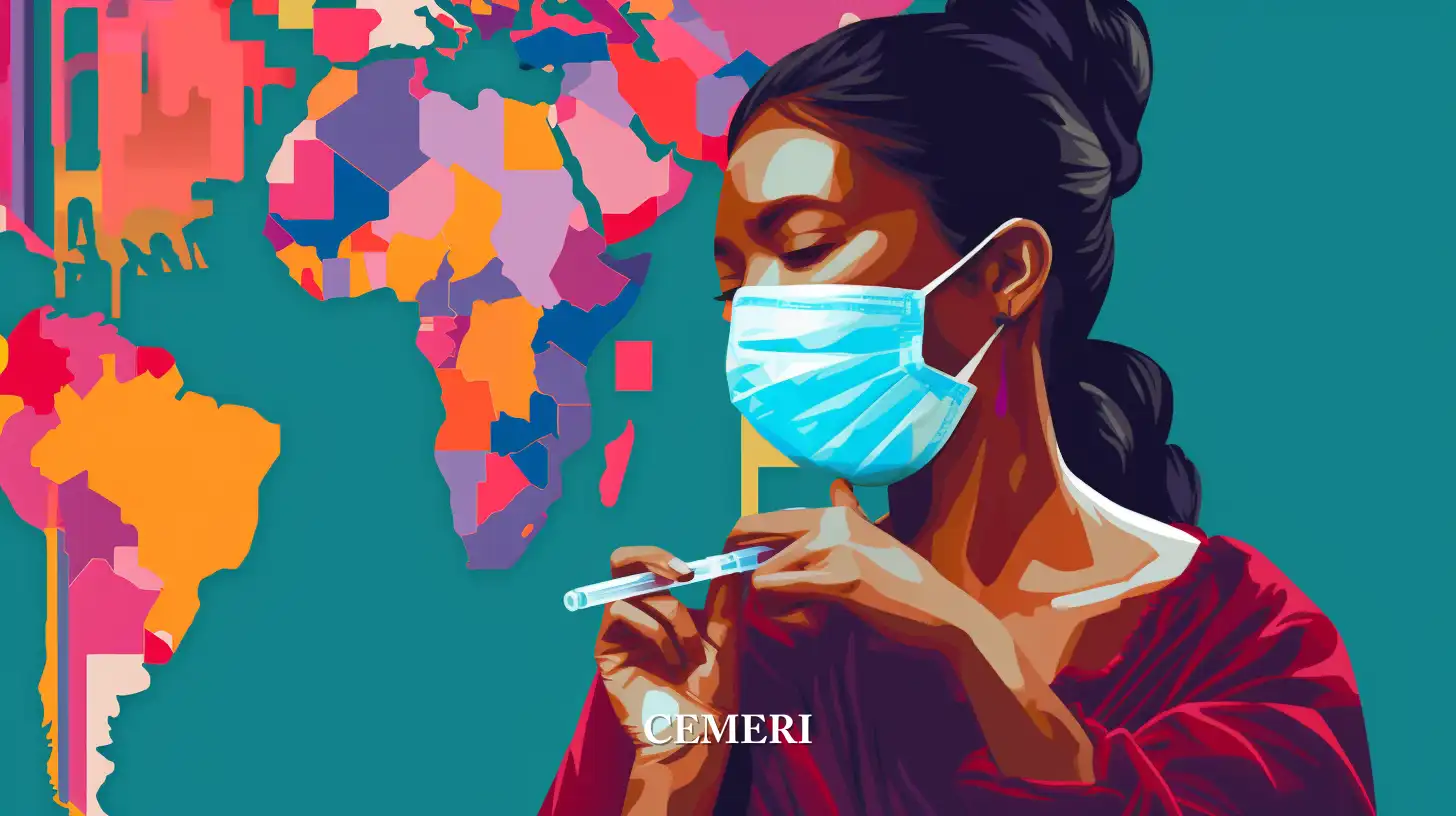Analysis
Diana Villalbazo
The geopolitics of vaccination: Mexico and Argentina
- The strengthening of the Mexico-Argentina relationship is a step in the geopolitics of vaccination within Latin America. What repercussions will it have?

The arrival of the Argentine president – Alberto Fernández – in Mexico on February 22, with an agenda that includes visiting the COVID vaccine packaging factory, represents the strengthening of the relationship between both countries. After the start of the pandemic in 2019, international cooperation and multilateralism have regained strength on the international scene as a result of the health emergency, an issue that is intended to increase in the region and is supported by the Economic Commission for Latin America and the Caribbean with the geopolitics of vaccination used by AMLO and Fernández.
The invitation extended by President Andrés Manuel López Obrador is immersed in the search for a bilateral, regional relationship and in terms of technological development, since in the latter case, the Mexican laboratory AstraZeneca and the Argentine mAbxience work jointly in the creation of containers that can package the vaccine developed by the University of Oxford. [1]
The virus worldwide has had repercussions on the economies of the most affected countries, among the Latin American region are Mexico and Argentina, which have presented difficulties in terms of managing the pandemic and specifically in the vaccination strategy. Various accusations have been made that point to the privilege of acquiring the vaccine, since it has been shown that both in the northern and southern countries, the distribution of drugs has been inequitable by focusing on the social elites who have the possibility of pay to get the vaccine faster.
The concentration of drugs in the most developed countries is one of the reasons why Mexico is currently one of the countries with the highest number of deaths, coupled with the mismanagement of the situation. This issue was denounced in the United Nations Security Council in response to the accumulation of 80% of vaccines worldwide in only 10 countries, which can be analyzed as nationalism in health, for which the invitation was raised. to the equitable distribution of drugs. [2]
Given the abuse in hoarding vaccines, some initiatives were created that seek access to countries that do not have the purchasing power to obtain them, such as COVAX created by the World Health Organization. It is intended to distribute the largest number of substances possible in order to stop the economic effects caused by the pandemic. [3]
On the other hand, in Argentina, cases such as "VIP Vaccinations" are also presented, where relatives such as family, friends and main partners of the sector in charge of distributing vaccines in a schematic manner in response to the most needy cases are supplied with the vaccine as the primary objective, an issue that has not been commented on by President Andrés Manuel López Obrador by not issuing any position in the face of such circumstances.
In this axis, the visit of President Alberto Fernández to Mexico calls for a series of questions immersed in: What does the rapprochement represent? Is more bilateral cooperation expected? Will the Mexico-Argentina relationship affect the rest of Latin America? Will the vaccines created be able to satisfy the demand of a sick society? What geopolitical repercussions will there be?
Mexico: Main effects
After the start of the pandemic in 2019, President Andrés Manuel López Obrador maintained that foreign policy was measured based on domestic policy, so in the first instance his government focused mainly on solving problems in Mexico. With the advance of the pandemic, international cooperation became fundamental within the framework of multilateralism to achieve the development of solutions that could attend to the global emergency, for which the country found itself in the need to delve into the dynamics.
Unfortunately, the proper handling of the pandemic was too late. AMLO's actions initially resulted in disbelief, followed by the lack of decision to declare quarantine and consequently confinement, so that the most affected sectors of the population are so far the workers and workers in the informal sector.
On the other hand, the way in which governments reacted to the situation is different in demand from the social reality to which they respond, since in Mexico a large part of the population suffers from job insecurity that entails the implementation of informal work. This aspect of Mexican society is not due to a recent past, but rather to the political processes that the country has gone through and that have been greatly affected in recent times.
Quarterly labor informality rate (Percentage of the employed population). Source: International Labor Organization based on INEGI from 2008 to 2020. [4]
In essence, confirmed cases of coronavirus in Mexico are 2,137,884 according to data from the National Council of Science and Technology compared to 2,192,025 in Argentina. In contrast, the number of deaths between both nations is abysmal given that in the first case there are around 194,490, unlike the 53,646 in Argentina. [5] [6]
This indicates that despite having a relatively equal number of confirmed cases, the deaths have had different impacts. Faced with the context, the territorially North American country sustains a greater impact in humanitarian, economic and social matters compared to Argentina.
Despite the circumstances, Mexico has begun to receive the 34 million vaccines agreed with the company Pfizer, with AstraZeneca 77.4 million, with Cansino 35 million and 51.5 million from COVAX. It is intended to carry out the second day of vaccination with the newly arrived substances. [7]
Within the current pandemic scenario, the two nations with leftist governments have apparently taken the lead within the region with the association they are creating for the vaccination of [Latin America](https://cemeri.org/opinion/vacunacion- massive-output-latin-america/). Argentina, for its part, received a load of the Russian Sputnik V vaccine, although later alliances with other pharmaceuticals resulted in mAbxience.
Argentina: The open case
For its part, the southern country, since the first cases began to appear, has acted with greater serenity and speed since two weeks after the health emergency began, progressive social isolation was declared as a preventive measure to avoid an increase in the number of cases. infections. This caused various impacts on the population in areas such as education, work and humanitarian losses. [8]
According to the development of the virus, a bimodal curve was created in terms of the number of infected in the system. Given this, it is argued that the corresponding tests were not carried out in due time, which could have prevented the increase in the number of infected, nor was a follow-up carried out on the cases that had already been detected in order to separate them from the healthy population.
In addition to the implementation of isolation, a strategic program for the supply of vaccination similar to the one maintained by Mexico was proposed, in which the first line regarding hospital personnel is medicated, followed by the elderly over 65 years and evolutionarily descend among the population until reaching the youngest.
In this context, the vaccine that was expected to be used was Sputnik V as of March, however, as a result of the delay in said matter, a way was sought to expedite the process through the visit to Mexico of President Fernández, which although It had originally been to participate as a special guest in the commemoration of the Bicentennial of the Promulgation of Iguala and Flag Day, it had also been used to tour the facilities where the vaccines will be formulated and packaged. [9]
The alliance for the production of the antigen with the country at the Liomont laboratory plant encourages a joint effort to create a substance that meets the needs not only of both countries but of Latin America in general to position itself as the main economies in the mainland, below the United States.
Is this alliance the hope of Latin America?
The visit of the Argentine president to Mexico implies geopolitical repercussions since beyond being a bilateral relationship in which the Strategic Association Agreement was reaffirmed, which involved the participation of the Political Affairs, Cooperation, Economic, Commercial and Investment commissions, it is a commitment to the future of public health in the continent, which is planned to be provided through international humanitarian assistance.
Given that the pandemic has wreaked great havoc in the region, in labor, humanitarian and economic fields, specifically in the informal sector as the most vulnerable, in addition to the monetary contraction of -7.7% in the drop in GDP that the region presented in 2020 according to data from ECLAC, it seeks to create a relationship through forums such as the Community of Latin American and Caribbean States or the G20 for cooperation and recovery, adding efforts that involve the management of upcoming epidemiological and natural risks by virtue of improving the adaptation to the phenomena that may occur.
In general terms, the most damaged economies have been Venezuela with a drop in GDP of -30%, Peru with -12.9%, Panama with -11%, Argentina with -10.5%, Mexico with -9% and Ecuador with - 9% Given the above, it is necessary to adopt greater control over the pandemic in relation to mortality, in order to reduce the number of human losses and have the capacity to reactivate the economy of the nations in question.
On the other hand, the inevitable dependence on the US economy, mainly from Mexico and Central America, has caused a greater recession since the North American country alone has suffered great impacts from the beginning that affect the countries that maintain economic ties like a domino. In contrast, South America shows a greater dependence on China in response to the relationship as the main partner that they have maintained since 2015. [10]
Regional integration is one of the key points that arise within the logic for economic-commercial reconstruction through political dialogue and cooperation in order to achieve capacity in the production of vaccines and which, in turn, are called "goods". global commons”, since they belong to the international level and should be able to reach all areas of the world at an affordable price. [eleven]
Sources
[1] Forbes Staff. 2021. Presidente de Argentina llega a México para reforzar alianza. Forbes México, 22 de febrero.
[2] Manetto, F. 2021. México y Argentina sellan un nuevo eje progresista en América Latina. El país, 23 de febrero.
[3] Organización Mundial de la Salud. COVAX: colaboración para un acceso equitativo mundial a las vacunas contra COVID – 19. OMS. https://www.who.int/es/initiatives/act-accelerator/covax (consultada el 10 de marzo de 2021).
[4] Felx, Noémie. 2020. Nota técnica. México y la crisis de la COVID – 19 en el mundo del trabajo: respuestas y desafíos. Organización Internacional del Trabajo.
[5] CONACYT, CentroGeo, GeoInt, DataLab. 2021. COVID – 19 México. Gobierno de México. https://datos.covid-19.conacyt.mx/#DOView (consultado el 14 de marzo de 2021).
[6] Argentina Unida. 2021. Información epidemiológica. Ministerio de Salud de Argentina. https://www.argentina.gob.ar/salud/coronavirus-COVID-19/sala-situacion (consultado el 14 de marzo de 2021).
[7] Redacción. 2020. ¿Cuántas y cuáles vacunas contra COVID recibirá México en 2021?. El financiero, 27 de diciembre.
[8] Chávez, V. 2021. Contrapunto: dos expertos analizan los aciertos y errores en el manejo de la pandemia a nivel local. Infobae, 3 de marzo.
[9] Secretaría de Relaciones Exteriores. 2021. Comunicado No. 091. Presidente de Argentina y canciller de México supervisan laboratorio donde se formularán y envasarán vacunas. México: Gobierno de México.
[10] UN. CEPAL. División de Comercio Internacional e integración. 2021. Informe. Perspectivas del Comercio Internacional de América Latina y el Caribe. Chile: Comisión Económica para América Latina y Caribe.
[11] Secretaría de Relaciones Exteriores. 2021. Comunicado No. 096. México y Argentina firman hoja de ruta para reactivar los mecanismos bilaterales de la Asociación Estratégica. México: Gobierno de México.

